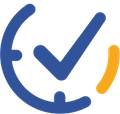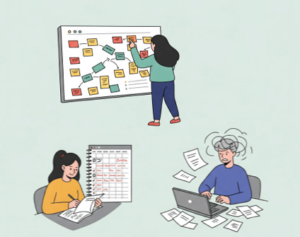Have you ever looked at your to-do list and wondered what it says about you? Task management isn’t just about getting things done—it reflects individual work habits, organizational skills, and even mindset. Some people meticulously plan every detail, while others thrive under last-minute pressure. Understanding different productivity styles can help optimize efficiency, and improve overall time management.
1. The Structured Planner
Structured planners rely on detailed to-do lists, schedules, and organized workflows. They thrive on precision, ensuring every task has a designated time and place. This approach minimizes uncertainty, allowing for better time management and productivity.
However, being too rigid can sometimes become a drawback, as unexpected changes can throw off an entire schedule. Structured planners may also spend excessive time planning rather than executing tasks, leading to inefficiencies.
Practical Tips:
- Maintain flexibility: Learn to adjust and adapt when plans don’t go as expected. Unexpected changes are inevitable, and flexibility can prevent frustration.
- Utilize digital tools: Task management platforms like Planndu allow for easy tracking and adjustments, ensuring no task is overlooked.
- Implement time-blocking: Allocating specific periods for planning versus execution can create a balance between preparation and action.

2. The Visual Organizer
Visual organizers use diagrams, color codes, and structured layouts to manage tasks. They process information best through visual cues, making their task lists more engaging and intuitive. Whether using sticky notes, mind maps, or color-coded spreadsheets, this approach enhances comprehension and retention.
While effective, visual organization can become overwhelming when too many colors or graphics are used. A cluttered system can lead to confusion rather than clarity.
Practical Tips:
- Simplify visual elements: Stick to a limited color scheme and avoid overloading with excessive imagery.
- Use consistent categorization: Assign specific colors or symbols to categories for clarity and to prevent misinterpretation.
- Keep a clutter-free workspace: Ensure workspaces (physical or digital) remain organized for better focus.

3. The Overcommitted High Achiever
High achievers often take on more than they can handle, believing they can juggle multiple responsibilities simultaneously. While their ambition drives them to accomplish a great deal, this approach can also lead to burnout, stress, and a never-ending to-do list.
A constant drive to be productive may cause them to neglect self-care and personal well-being. Learning how to prioritize effectively is crucial for maintaining sustainable productivity.
Practical Tips:
- Set clear priorities: Distinguish between high-priority tasks and those that can wait. Avoid saying yes to every opportunity.
- Adopt time management techniques: Methods such as the Pomodoro Technique encourage structured work intervals to prevent exhaustion.
- Take regular breaks: Incorporate downtime into the schedule to recharge and avoid burnout.

4. The Deadline-Driven Worker
Some individuals perform best under pressure, relying on impending deadlines to spark motivation. While this can result in bursts of productivity, it also introduces high levels of stress, rushed work, and occasional procrastination.
Deadline-driven workers often struggle with time mismanagement, as they delay tasks until the last possible moment. This approach can lead to compromised work quality and increased anxiety.
Practical Tips:
- Establish self-imposed deadlines: Setting earlier due dates creates a safety buffer, reducing last-minute panic.
- Break tasks into smaller steps: Segmenting large projects into manageable sections can make them feel less overwhelming.
- Prioritize task clarity: Ensure every deadline is tied to a clear and well-defined objective.

5. The Conceptual Thinker
Conceptual thinkers excel at generating ideas but often struggle with execution. They are visionaries, coming up with innovative concepts, but translating these ideas into concrete actions can be a challenge.
Without structured steps, projects may remain in the idea phase indefinitely. Conceptual thinkers need frameworks that help them turn their creative visions into achievable goals.
Practical Tips:
- Set specific goals: Using the SMART criteria (Specific, Measurable, Achievable, Relevant, Time-bound) provides clarity and direction.
- Develop an action plan: Breaking down big ideas into sequential steps ensures steady progress.
- Focus on achievable milestones: Work in smaller phases to track progress and avoid feeling overwhelmed.

6. The Minimalist Doer
Minimalist doers focus on efficiency, stripping tasks down to their core essentials. They avoid unnecessary steps, ensuring their to-do lists remain simple and actionable. This approach fosters productivity by eliminating distractions and focusing only on what truly matters.
However, the minimalist mindset may sometimes lead to the neglect of important but less urgent tasks, such as long-term planning or professional development.
Practical Tips:
- Regularly review tasks: Ensure all necessary activities are accounted for without sacrificing important long-term goals.
- Use prioritization frameworks: The Eisenhower Matrix can help differentiate between urgent and important tasks.
- Maintain balance: While simplicity is valuable, make sure essential but non-urgent tasks are not overlooked.

Productivity styles vary, and most people don’t stick to just one approach. Depending on the task, deadline, or mood, individuals may shift between different styles. By recognizing and refining these habits, efficiency can improve, and stress can be reduced. Digital tools like Planndu support this process by offering features tailored to different productivity needs.




